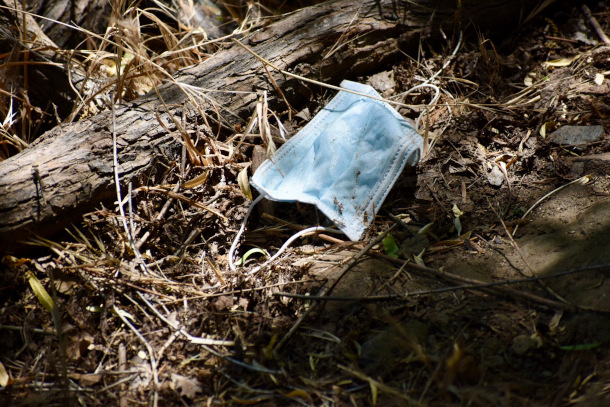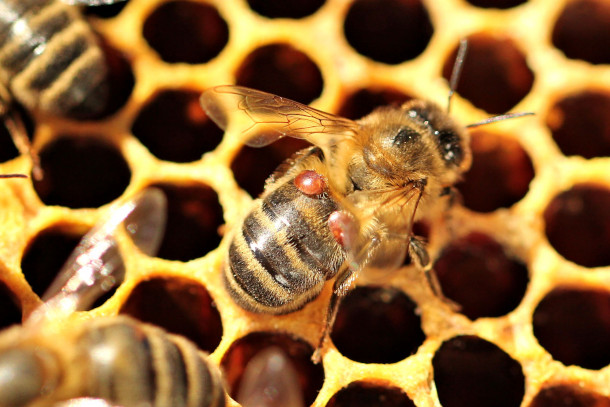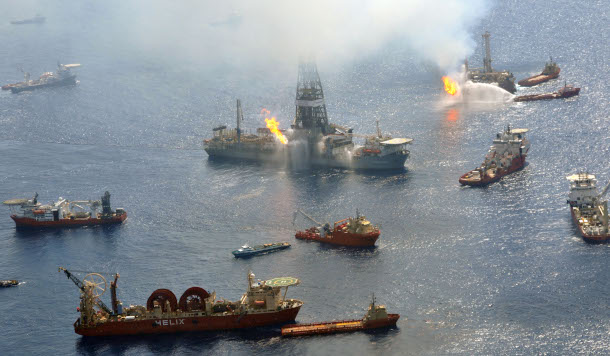Beyond the Headlines
Air Date: Week of May 6, 2022

Researchers at Washington State university found that repurposing facemasks and using them in cement could make concrete 47% stronger which can potentially reduce the over 1500 million facemasks discarded every year. (Photo: Babette Plana, Flickr, CC BY NC 2.0)
On this week's trip beyond the headlines, Host Steve Curwood talks with Environmental Health News' Weekend Editor Peter Dykstra about a study that shows how the fibers in discarded face masks could potentially strengthen cement. They then chatted about a new honeybee, bred by the United States Department of Agriculture, that could potentially be resistant to varroa mites, a parasitic mite which causes disease and death in European honeybees, which are widely used in commercial agriculture as pollinators. And then from the history books, the two recount when an American right wing political commentator falsely accused eco-terrorists of the 2010 Deepwater Horizon oil spill after the British Petroleum Company had already apologized.
Transcript
CURWOOD: It’s Living on Earth, I’m Steve Curwood.
And for our walk behind the headlines today, we're gonna be talking as usual with Peter Dykstra. Peter's an editor with Environmental Health News that's ehn.org. And dailyclimate.org. He's down there in Atlanta, Georgia. Peter, what do you got for us today?
DYKSTRA: Hi Steve, we're gonna start with something that's potentially good news. The COVID pandemic has left us with a situation where we're up to millions of disposable face masks per minute. Being thrown out after one use estimated 1500 billion face masks around the world in a single year. But we may have found something that makes those face masks have a second life and something that actually in a small way could address climate change.
CURWOOD: Okay, Peter, I'm wide open for this possibility. What do you got?
DYKSTRA: Well, the single use medical masks are usually made of polypropylene or polyester fabric, tiny fibers that may have a second life in the concrete industry. Concrete use has gone wild in recent years. As the developing nations ramp up their economies, concrete buildings are going up everywhere. But those microfibers in masks can be added to cement. And a Washington State University research project says that they can help make concrete stronger while dealing with a big disposable.
CURWOOD: Concrete certainly has an influence on the climate, I think what 8,10% of emissions are from cement kilns. So how much stronger would these mass materials make concrete?
DYKSTRA: There's one estimate that says possibly nearly 50% stronger. Those masked materials can help the builders in addition to helping the disposers throw away less.
CURWOOD: Yeah, and a great thing about this possibility is, is that concrete breaks down. You know, you may notice the odd bridge that collapses and such like that, that stuff wears out. If these fibers from all these masks can make these things stronger it's all to the good. I hope this works out, Peter. Hey, what else do you have for us?
DYKSTRA: Another potentially good thing for the environment. We've reported for years that honeybees are under serious threat, there's a real possibility that they could vanish someday. There are so many honeybee colonies lost from summer to winter to summer again, as much as nearly 30%. That's because of a number of threats, these pesticides changes in local habitat, loss of honeybee nutrition. But one of the biggest threats it's believed are a tiny invader called varroa mites brought over here from Southeast Asia in 1987. Scientists at the USDA, the Department of Agriculture, believe they've bred a new bee that's resistant to varroa mites.

Varroa mites latched on to the back of a honeybee, bees which are widely used in commercial agriculture as pollinators. The Varroa Mite is an external parasitic mite which attaches to the body of the bee in order to feed on hemolymph. In the process the mite spreads viruses that can lead to death and a significant infestation can lead to the death of a bee colony. (Photo: Absolute Folly, Flickr, CC BY-NC-ND, 2.0)
CURWOOD: So Peter, what's the buzz on these bees?
DYKSTRA: The buzz on these bees is that it's potential. That with this new honey bee breed, replacing the European honey bees that have absolutely no natural defense to varroa mites, that we could save bee colonies without losing the honey they produce, or the pollinating feature that's so important that they perform for other food crops throughout the world.
CURWOOD: Yeah, boy without the bees, there's a lot of food we wouldn't have so I like the sound of this.
DYKSTRA: If it all works, it's a win win.
CURWOOD: Okay, let's take a look now back in history, Peter. Tell me, what do you hear?
DYKSTRA: April 29, 2010. One of the champions of fake news and conspiracy theories was of course the late Rush Limbaugh. Mr. Limbaugh died last year. But right after the Deepwater Horizon disaster he went on his nationally syndicated show and suggested that eco terrorists had deliberately caused the Deepwater Horizon oil spill.
CURWOOD: Wait, Peter almost immediately BP itself said that they messed up by allowing this well to blow out. What gave Limbaugh the notion that somehow he could say that there were eco terrorists involved?
DYKSTRA: Well, you know when BP immediately apologized for its role in causing the spill, I began to grow a little bit suspicious that they had actually helped cause the spill. But not Rush Limbaugh. He stayed on it and actually doubled down a few days later, when he added that not only were eco terrorists using this as a lobbying chip for climate and energy legislation but in addition they had done it to promote Earth Day. You'll remember that the well blew on April 20th and the massive spill was detected two days later April 22, Earth Day. A true conspiracy waiting for someone like Rush Limbaugh to knock it out of the park.

On April 20, 2010, the oil drilling rig Deepwater Horizon, operating in the Gulf of Mexico, exploded and sank resulting in the death of 11 workers and the largest marine spill in history. In 2012, the oil company BP agreed to accept criminal responsibility for the disaster. (Photo: Casey Ware, Flickr, CC BY 2.0)
CURWOOD: Well Peter, we don't have Rush Limbaugh around telling outrageous lies but I think a lot of people have picked up his mantle and moved it forward sadly.
DYKSTRA: Well, I'll get back to you after the 2020 election is resolved.
CURWOOD: Thanks. Peter Dykstra is an editor with environmental health news, that’s ehn.org and dailyclimate.org. We'll talk to you again real soon.
DYKSTRA: All right Steve, thanks a lot. Talk to you soon.
CURWOOD: And there's more on these stories on the Living on Earth website that's LOE DOT ORG.
Links
Cosmos | “Disposable COVID Masks Make Stronger Concrete”
Read the study on repurposing face masks for concrete
The Week | “The Conspiracy Theories Behind The BP Oil Spill”
Living on Earth wants to hear from you!
Living on Earth
62 Calef Highway, Suite 212
Lee, NH 03861
Telephone: 617-287-4121
E-mail: comments@loe.org
Newsletter [Click here]
Donate to Living on Earth!
Living on Earth is an independent media program and relies entirely on contributions from listeners and institutions supporting public service. Please donate now to preserve an independent environmental voice.
NewsletterLiving on Earth offers a weekly delivery of the show's rundown to your mailbox. Sign up for our newsletter today!
 Sailors For The Sea: Be the change you want to sea.
Sailors For The Sea: Be the change you want to sea.
 The Grantham Foundation for the Protection of the Environment: Committed to protecting and improving the health of the global environment.
The Grantham Foundation for the Protection of the Environment: Committed to protecting and improving the health of the global environment.
 Contribute to Living on Earth and receive, as our gift to you, an archival print of one of Mark Seth Lender's extraordinary wildlife photographs. Follow the link to see Mark's current collection of photographs.
Contribute to Living on Earth and receive, as our gift to you, an archival print of one of Mark Seth Lender's extraordinary wildlife photographs. Follow the link to see Mark's current collection of photographs.
 Buy a signed copy of Mark Seth Lender's book Smeagull the Seagull & support Living on Earth
Buy a signed copy of Mark Seth Lender's book Smeagull the Seagull & support Living on Earth

